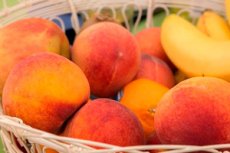Peaches in diabetes mellitus type 1 and 2: is it possible or not?
Last reviewed: 23.04.2024

All iLive content is medically reviewed or fact checked to ensure as much factual accuracy as possible.
We have strict sourcing guidelines and only link to reputable media sites, academic research institutions and, whenever possible, medically peer reviewed studies. Note that the numbers in parentheses ([1], [2], etc.) are clickable links to these studies.
If you feel that any of our content is inaccurate, out-of-date, or otherwise questionable, please select it and press Ctrl + Enter.

Although diabetes mellitus places restrictions on many foods rich in carbohydrates, it is difficult to resist such temptation when summer comes and the shelves are full of juicy, fragrant fruits. In addition, each person tries to restore and strengthen his health in the season of fresh vegetables and fruits, replenish the body's stores with nutrients. Rarely meet people who would not like peaches. But is it possible to have them with diabetes?
Can I eat peaches for type 1 and type 2 diabetes?
For diabetics, it is important to control blood sugar levels. To do this, you need to know the glycemic index (GI) of the consumed product. It means how this level changes when you eat 100g of food with the same amount of glucose. Its source is carbohydrates, which are divided into fast and slow. The first are quickly digested and greatly increase the sugar, the second - are absorbed into the tissue gradually, without leading to a sharp jump in glucose. A diabetic diet should include predominantly slow carbohydrates. What is the position of peaches and is it possible to eat them in type 1 and type 2 diabetes? Analyzing the glycemic index of individual products, we see that buckwheat has a figure of 50, semolina - 65, rice - 60, banana - 60, apricot -20, peach -30. It turns out that peach is not the most dangerous product for diabetes. But everything is individual and the question will be clarified by consultation with an endocrinologist. If the doctor does not put a taboo on this fruit, then one day without supplementing other sweet fruits is quite acceptable.
Peaches for Gestational Diabetes
This type of disease is characteristic of pregnant women. Hormonal changes, inherent in the period of childbearing, sometimes lead to the fact that the body is not able to absorb its own insulin, and the pancreas does not withstand stress. In most cases, after birth, everything returns to normal, but in order not to get complications in the future, you need to eat right. Peaches for gestational diabetes, as well as apples, oranges, pears, are present in the pregnant menu. They are recommended to eat not in the main meal, but as snacking and in moderate quantities.
Benefits
Knowing the beneficial properties of peaches, no one would even think of abandoning them. The fruit has low energy value (39kkal per 100g of weight), therefore, it is often used in diets for weight loss. There is a lot of β-carotene in it, there is ascorbic acid, vitamins K, B1, B2, B3, B5, E. Among the minerals there is the most potassium, less phosphorus, magnesium, manganese, calcium, fluorine. Peach pulp is rich in organic acids: citric, tartaric, malic, quinine; essential oils and pectins. This wealth is enough to improve the condition of the heart and blood vessels, digestion, organs of vision, improve metabolism, increase the body's resistance to infections and various diseases.
Common peach varieties include:
- nectarine - it is also called naked peach, because he has no fluffy shell. Its glycemic index is slightly higher than usual (35), but in terms of its chemical composition it is not inferior to it and even surpasses it. Its fiber cleanses the intestines from toxins and slags, it has antioxidant properties, normalizes hormones, strengthens the immune system, promotes the growth of muscle tissue. Nectarine in diabetes mellitus type 2 can be consumed, but in limited quantities, controlling bread units (100 g of fruit is equal to 1 XE);
- diabetes peach in diabetes - has a flattened shape, as if pressed in the middle, and its flesh is soft and juicy. This subtype has all the previous characteristics. Pamper yourself with one fruit a day with diabetes is quite possible.
Contraindications
Peaches are undesirable for obesity, allergies (especially fruits with velvety skin), a tendency to nervous excitability. They are contraindicated on an empty stomach for people with high acidity of the stomach, and in large quantities can cause indigestion.
 [3]
[3]
Forbidden fruits with diabetes
A high glycemic index is considered to be from 70 to 90. Forbidden fruits in diabetes include those whose GI is in this range. We list them:
Juices from any fruit will harm the diabetic, because the concentration of carbohydrates in them is higher than in the fruits. It is also impossible to use dried fruits, but compotes of them can be, if you pre-soak them overnight, then drain the water.

Reviews
Reviews of people with diabetes, suggest that many allow themselves to eat delicious and fragrant fruits, but at the same time depriving themselves of other sugar-containing products. The main thing is to keep sugar under control with the help of a glucometer.

